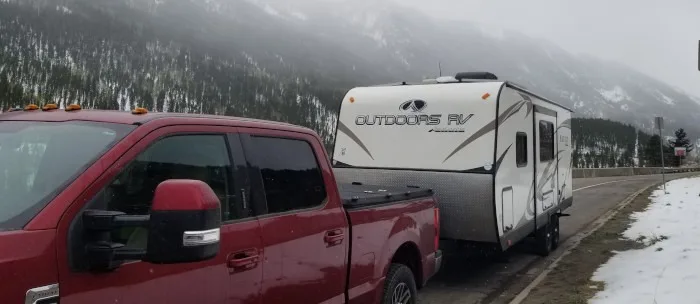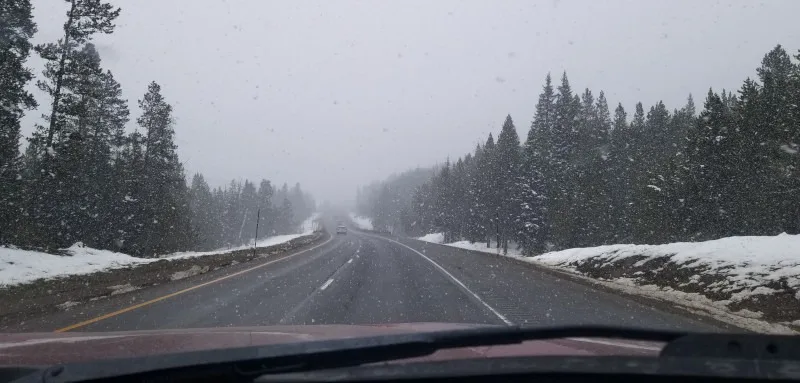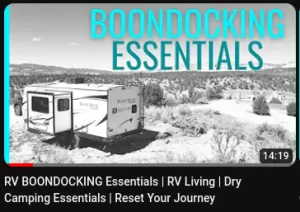Last Updated on 05/11/2024 by Glynn Willard
What’s it like to tow a travel trailer over Vail Pass?
We heard so many horror stories and watched videos long before we made the attempt to tow over Vail Pass.
Honestly, my concern was unwarranted.
We pulled our trailer over Vail Pass at the end of May.
And yes, it was snowing at the top!
We were headed east on Interstate 70, saw signs and my knuckles grew white!
I had worked myself up because of our experience on Wolf Creek Pass.
Fortunately, I had a lot more experience towing over mountain passes at this point. I was well prepared.
Does Vail Pass Have Hairpin Turns?

There are several sweeping turns, but no switchback, hairpin turns on Vail Pass.
This doesn’t mean that one can drive recklessly along Interstate 70 through Vail Pass!
Driving under control should always be the priority when towing a trailer over any mountain pass.
As you already know, speed is your enemy and a controlled slow pace is your best friend.
Use your brakes as sparingly as possible to prevent overheating. Use your gears and engine brake instead.
What’s the rush anyway? The scenery is gorgeous!
Vail Pass Elevation

Vail Pass has a peak altitude of 10,662 MSL.
Heading east, the climb to the top becomes mildly noticeable after passing through Edwards.
The gains really kick up from Eagle-Vail to the top of Vail Pass.
From Eagle-Vail, the total elevation gain to the top of Vail Pass is approximately 3000 feet.
It’s 24 miles from Eagle-Vail to the top of Vail Pass. That sounds like plenty of mileage, but there are some steep grades.
And the 7% grades will not let you forget that you’re climbing a great distance.
Of course your engine will remind you that it’s working hard!
The memories of towing through Wolf Creek Pass still haunting me, I was surprised when we reached the top.
Again, it was snowing, but ultimately, the actual climb was a lot easier than Wolf Creek Pass.
The descent from Vail Pass to Silverthorn is an elevation loss of approximately 1600 feet over 16 miles. Not too bad.
But wait, you’re not done!!
Now you have to climb back up to 10,300 feet (a gain of almost 1300 feet) before you start to descend again.
Vail Pass Grade

Both the east and west sides of Vail Pass have close to 7% grades.
It’s not the worst, but it will still exercise your engine and brakes a lot!
Total Time To Cross Vail Pass
An experienced driver can likely cross Vail Pass in good conditions under an hour (west to east).
Yeah, in a car not towing anything!
It’s approximately 38 miles long, so if you’re towing something slowly, budget about an hour in good weather.
Budget more time for wet or snowy weather.
I suggest stopping to rest the tow vehicle’s engine and brakes (and trailer brakes) at the top and enjoy the views.
Give yourself a break and enjoy the fresh high elevation air!
You’ve got some more climbing to do toward the Eisenhower-Johnson Memorial Tunnel anyway.
Be Aware Of The Weather On Vail Pass

Long hauls in inclement weather are exhausting and cold.
If there are cold temperatures and precipitation predicted, be prepared with the correct tires and possibly chains.
Vail pass closes on occasion due to heavy, fast accumulating snow, so check before crossing in the winter.
Vehicles exceeding 16,000lbs are required to use chains in snow and have them onboard from 9/1-5/31.
If you have no experience with these conditions and you’re towing, skip it. This is not the place to learn.
Ice on mountain passes can be deadly to any vehicle. Especially heavy trucks towing a camper.
So, again, before you embark on the journey over Vail Pass, know the weather on all parts of the drive.
This part of I70 is well maintained year round, but that doesn’t mean rapid freezing or snow accumulations does’t happen.
Is Your Camper And Tow Vehicle Equipped To Cross Vail Pass?

Seriously, your engine brake is your friend while decsending either side of Vail Pass!
I learned to use our engine brake on our 2017 F250 diesel on Wolf Creek Pass.
Talk about being thrown to the wolves (pun intended)!
I had to break out the truck’s manual to learn how to properly use the engine brake.
It took a few tries before I trusted it to “do its thing.”
So if your originally from a flat region, brush up on how it works before ascending Vail Pass.
Also, to state the obvious, make sure your tow vehicle and trailer have quality brakes.
Oh and make sure you don’t approach Vail pass with your low fuel light on.
That should be a no brainer, but it’s worth saying.
Not Sure What You Need For Your RV?
Test Your Brakes Before Going Over Vail Pass
Test your tow vehicle and trailer’s brakes before ascending either side of Vail Pass.
If you have a brake control, confirm that your trailers brakes are ready and willing.
They should stop your tow vehicle from an un-accelerated coast.
I know it sounds like the obvious, but I forgot to test my brakes on several occasions when we first got started.
It wasn’t until I had a lot of experience towing and doing preventative maintenance that I established so many safety checks.
This is a another situation where it’s really good to know your trailer and tow vehicle’s systems inside and out.
Again, it might be obvious, but use your brakes sparingly. The last thing you need is them overheating.
RV Etiquette: Let Them Pass

This applies to all RV drivers because it’s just the right thing to do.
Despite the fact that I70 over Vail Pass is a multi-lane road all the way, it’s still worth mentioning this point.
If you’re holding up traffic because of your slow pace, pull off at the first opportunity and let vehicles pass.
We’ve all been stuck behind a slow vehicle and we all genuinely appreciate the few that pull off to allow passing. High five!
Several states have made it a law that if you’re backing traffic up, you have to pull off and let vehicles pass.
Colorado is one of those states.
Kindness on the roadway goes a long way.
Wrapping Up Crossing Vail Pass With A Camper

If your journey takes you over Vail Pass and your towing a camper, keep the following in mind:
- Know the weather and plan accordingly. I can’t stress this enough about Vail Pass.
- If snow accumulation is in the forecast, know and understand Colorado’s chain laws for highways.
- Speed is not your friend. Take your time and budget a little over an hour.
- Is your tow vehicle and camper equipped with good quality, robust brakes?
- Check your brakes before the assent and use them sparingly. Your lower gears and engine brake should be your go to when going downhill.
- It’s all about taking your time and remaining under control both up and down.
- If you’re the slow camper (and you should be), let the traffic pass that’s built up behind you.
Take in the beautiful views that Vail Pass offers and enjoy the journey!
What’s the most difficult mountain pass you’ve towed a camper over?
Meet the author.
We appreciate any help to bring you great content. Donate or buy us a coffee on our Ko-Fi site. Or subscribe to our YouTube Channel. Thank you so much for being here!



